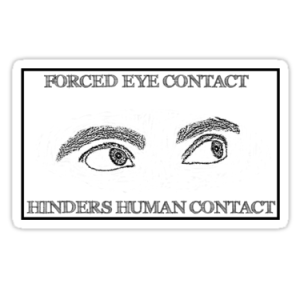
Wild asters, an early autumn burst of bright purple with orange centers, blooming untended by a grey weathered fence near Burnside’s Bridge at the Antietam Battlefield. Photograph copyright 2016 by Sparrow Rose Jones
This is a re-blog of a blog post originally made on 7 November, 2014.
Content note: discussion of bad therapy, including video footage of a suffering child.
About a month ago, I wrote about the types of therapies used with Autistic children. I mentioned the sorts of practices that are not advisable and what to look for to see if the therapy your kid is getting is helpful or harmful. I was thrilled to hear from lots of parents whose children are getting great therapy that builds them up in many ways. I am so happy that there are professionals out there who understand autism and work to help kids grow up to be their happiest, most productive Autistic selves instead of training them to pretend to be someone they aren’t.
Many other people asked for something more specific than the words I wrote. Some people gave me links to videos and asked me to comment on them. Others asked me if I had videos that showed good or bad therapy practices. That’s what this post is all about. This is important stuff and many people specifically asked me to do this. It is not my intention to publically shame anyone by using publically available videos. I am sharing one video that I found particularly disturbing and two video examples of good therapies in the hopes that seeing these examples will help make the ideas I write about more visual and understandable.
I’d like to start with a four-minute video titled “Isabella 22- Knock-down drag out battle for Severely Autistic Child to attempt Speech“. I want to warn the sensitive that this is a difficult video to watch. Many of my Autistic friends were unable to watch the video or could only watch a few seconds before they had to turn it off because of the level of suffering and because of the difficult memories it triggered in them. I watched this video several times so I could analyze and write about it and it was very hard for me, too. There are reasons why I am only sharing one example of harmful therapy and one of those reasons is that I just can’t handle watching very much of it myself.
And, again, I want to emphasize that I am not accusing Isabella’s parents of anything. I am 100% sure that they are loving parents who care deeply about their child and her future and who believe that they are helping her to have a better life with the therapy they are providing for her. But I cringe in pain when I see what the poor girl is being put through in the name of helping her. I assume her parents put this video online to help others know more about therapy. Please take my comments in that light as well.
Let me start by talking about my broad impressions of this therapy session. Just the title of this video is a first clue about the attitude the adults in her life have toward Isabella’s therapy. They call it a “knock-down drag out battle.” Now, I’ll be the first to admit that parenting, or being parented, can often be a battle of the wills. I was a pretty difficult kid and I’ll admit that. But this video is nearly four minutes of Isabella crying with frustration and confusion while her therapist repeats “ma ma ma!” at her, over and over, trying to get Isabella to say “mama” and get gummy bears as a reward.
The therapist showed her candy, then withheld it from her while making lots of confusing sounds at her and leaving Isabella to try to figure out what the heck was going on, what was expected of her, and why she could see but not get the candy. If I dangled candy in front of a child but refused to give it to her and made her cry with frustration, you would call me a bully and say I was taunting the child and that I should stop making the little girl cry and just give her the candy, right? But because Isabella is Autistic, some professionals believe it’s not cruel; it’s therapy.
There are so many important things to say about this short video of a therapy session. Something really important, though, is that this is not in line with the ways language acquisition occurs. What is happening in this therapy session is closer to the way animals are trained to perform tricks. When I was a pre-teen, I taught my standard poodle to shake paws. He never understood what a handshake meant to me – all he ever knew was that it made me very happy if I put out my hand and he put his paw in it. And he liked to make me happy, so he learned to shake paws very quickly and would do it every time I offered my hand. And I never used food to teach him, just affection. And I never made him whine with confusion or behave in a distressed manner.
Now, I don’t mean to compare an Autistic child to a dog. That would be demeaning. But look at this speech therapy and tell me that Isabella is not being trained like a dog to mimic a behavior she doesn’t understand any more than my dog understood a handshake. In fact, Isabella is being treated far worse than most dogs are treated, because she is in real distress as she tries to get the candy and has no idea what is going on or why she keeps getting teased with candy. This is exactly the sort of trial-and-error behavior shaping you see when people train monkeys or bears to perform in circuses. It assumes that the subject being trained is incapable of understanding anything and must be bullied, badgered, and tempted until it randomly performs the act (or makes the sound) and then operant conditioning is applied to strengthen the desired response. This is not speech therapy, it is monkey training and, my apologies to Isabella’s parents, but it is painful to watch. This is not a therapy that respects Isabella’s personhood or addresses her needs.
Not only is this treatment cruel, it is setting the stage for potential future violence. This kind of therapy creates massive amounts of frustration in people who have limited ability to express their needs and wants and who are often not allowed agency or autonomy. Right now, Isabella is wringing her hands and pulling at her clothing. How much of this can she take before she starts pushing the therapist away? When pushing doesn’t make the frustration stop, how long will it take before she resorts to hitting or biting? I was a hitter and a biter, and just watching Isabella’s frustration makes me want to forget everything I’ve learned that keeps me from hitting people now.
This is really important. People worry a lot about their “violent” Autistic children as they get bigger and stronger and harder to control. But far too often, the “violence” is stirred up by years of very frustrating therapy just like the session you are seeing in this video of Isabella. There’s only so long that a person can take being pushed into sobbing meltdowns of frustration before they are willing to do whatever it takes to get the torment to stop. It is not only heart-breakingly cruel to treat a child this way, it is grossly irresponsible. Therapy like this creates problems. The best it will produce is a child trained to do things that make no sense in order to avoid distress and get rewards. The worst it will produce is a child that bites, kicks, hits . . . and gets bigger and stronger along with becoming less and less controllable. This therapy is not designed to raise a child who feels safe and comfortable with who they are, who feels safe to express their individuality, who is mentored in growing and developing into the best person they can be, expressing their true nature in ways others can come to connect with. The goal of being “indistinguishable with their peers” is a goal meant to make other people feel comfortable and happy. The goal of any therapy for an Autistic child should be to help the child feel more comfortable and happy. Therapy is not supposed to be about performing for others – it is supposed to help a person grow and express themselves in the truest, healthiest way possible.
At 58 seconds, Isabella gives up and starts to wander away. The therapist gets her attention and shows her the candy again. Isabella goes back to crying because it is so frustrating for her. From her perspective, she is being teased and taunted with candy she can’t have. She doesn’t understand what the therapist wants from her and she is filled with anger and frustration and probably a massive sense of unfairness about the whole ordeal. At 2:20, the therapist says “any sort of verbalization.” Isabella is making plenty of verbalization and some of it is even pretty close to an M sound, but the therapy continues and those verbalizations aren’t rewarded. How confusing for the little girl!
And listen to what one adult says at 3:25 – “we can’t let you win.” What? Isabella is frustrated, angry, upset, crying, has no idea what they want, has made lots of “mmmmm” noise, has put up with having her lips pinched, having people make tickly uncomfortable sounds against her forehead, and the adults are framing the whole thing as some kind of battle of the will that they can’t let her win? This is not a game to the little girl. She is not resisting making the sound because she is obstinate. That comment, about not letting her win, is possibly the most upsetting thing about this video for me. It’s not a game. It’s cruel. It’s confusing. And I am sure that Isabella is not thinking of this session in terms of getting the upper hand or refusing to give the adults what they want.
So how else can speech therapy look? Well, here’s an example: RPM – how it’s helping non-verbal autistic children. These are not isolated cases – I know children and their parents who are using RPM to learn expressive language. Over and over, I hear the same story: the people around a child think they are “not in there,” are deficient, incapable, not understanding, unable to communicate, or other similar or related thoughts. Then RPM is brought in and suddenly everyone is shocked to learn that the child they thought was “sleepwalking” through life was actually soaking up knowledge like a sponge. I have also known parents of children who did not get any kind of language therapy but their child spontaneously began spelling words on an iPad or with magnetic letters.
I have a few big problems with much of the standard speech therapy:
1. the emphasis on speech-only. I won’t deny that speech is very important in this world, but some people never speak. Will we never give them a way to communicate? To me, that feels like punishing someone for being unable to speak. Deaf children who are taught sign first have better overall language skills, whether they learn to speak later or not. Their written English is better if they are allowed to start with sign instead of being pushed to only speak and write English. Autistic children are the same way. If you want good future language skills, don’t insist on only one method of communication now. Allow signs and gestures. Work with pictures. Try RPM or another similar method of spelling. Try everything and don’t make your child get stressed about language. The more you can open up your child’s options for communication now, the better their overall language acquisition will be for the course of their entire life.
2. The emphasis on getting children to say things that please others rather than things that please parents. Isabella was supposed to say “mama.” Over and over, I hear parents say they suffer because their child doesn’t say “I love you.” I find it unsettling that there is so much focus on getting children to say things other people want to hear. I rejoice when I see children learning to say “I’m hungry” “I hurt” I want” and “no.” Teach a child the things the child will want and need to say. “I love you” can come later. Be honest: those three words, “I love you,” are for you, not for your child. Therapy should not be selfish – it should be about giving the child the tools that are important to the child.
3. The teaching methods that involve lots of emotional stress and confusion. Don’t underestimate Autistic people. We often look like we aren’t paying attention and aren’t understanding. Give us a chance. Don’t just assume that you have no choice but to train us with candy and tears. Look for therapies and teaching methods that enlist us as partners in our education.
I have another video to show you. I asked my friends to share therapy videos they especially like and this five-minute Sensory Diet therapy video (sadly, this video is no longer available on YouTube) came from Cynthia Kim at Musings of an Aspie.
First, look at how much fun the kids are having! This is something I heard a lot from parents after my ABA post last month – that their children love the therapy they get and they laugh and rejoice and only cry when it’s time to leave because they want to keep going. That warms my heart beyond the telling! Yes! If your child loves therapy, you chose well.
This physical play therapy the kids are doing is really important stuff. The narrator mentions that the play is engaging their vestibular and proprioceptive senses and helping them to feel like they are a part of their body, connected. It is impossible to overstress the importance of this sort of sensory play. I am here to tell you that feeling disconnected with one’s body has repercussions you can’t even imagine. I work to get “in” my body more and my body-mind disconnect affects nearly every aspect of my life. It is imperative to know, hear, and trust your body. Help your child to feel more connected to their physical existence and you will have a calmer, more centered, more confident child.
The kids are learning other stuff in this therapy, too. They are learning interaction with others, they are learning to ask for what they want and need, they are learning to take turns and consider others. There is a lot of social learning that is happening while they are focusing on body learning. This is great therapy! I admit, I’m a bit envious – I wish I could go play, too.
I hope that sharing these videos and talking about them has helped to make the idea of helpful vs harmful therapy more concrete and clear for you. I sometimes hear parents say that these ideas are great for kids with “mild autism” but their child is “too severe” and needs more. You might already know that I feel that separating the Autistic world into “mild” and “severe” (or any other similar division you might choose) is harmful to all Autistic people. But beyond that, thinking this way about your child is harmful to your child. No child is “so severe” that they need to be made to suffer. If therapy time is stressful for your child (and especially if therapy time is stressful for the whole family) you really want to think about the therapy you’re using and what the goals are and whether those goals are worthy of your beautiful child or not.
I want to leave you with a link to a blog entry – Caregiver Burnout from Love Explosions. The entry was written to address parents who feel burned out with everything that goes into caring for autistic children, but it is far more valuable than just that stated goal. read this blog entry because it paints a picture of what a healthy family looks like. The author has two beautiful daughters, one of whom is Autistic. If you are one of those parents who thinks the ideas I’ve been talking about here don’t apply to your family because your child is “too severe,” you should know that the Autistic daughter in the Love Explosions family is non-speaking and has epilepsy and is, by any way you would choose to measure “very severe.” (Although that is not the way I think of Evie! To me, she and her sister are beautiful, bright, wonderful girls who I think of first as little sisters and second as dear friends.)
This blog entry will show you what a happy, healthy household with an Autistic child can look like and what “therapy” and education for an Autistic child who is developing wonderfully into a healthy, happy Autistic adult can be. There is a lot to learn in Beth’s entire blog, and there is much wisdom to be gained in this one entry about living happily together as a family. I urge you to read Beth’s words and take them to heart.
added note: On the old blog, a commenter thanked me for mentioning RPM and gave a link to a blog written by a young man who uses RPM to communicate. I didn’t want that blog link to get lost when I moved this post to the new blog, so I’m including it here. Please visit: Faith, Hope, and Love … With Autism











Recent Comments